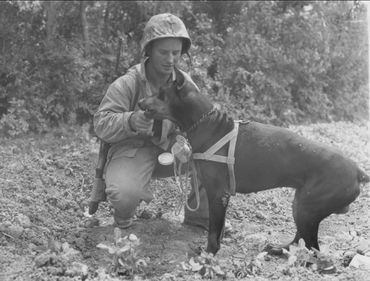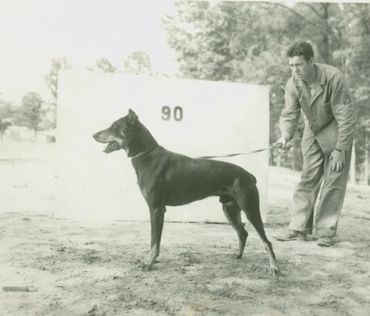History of the Dobermann
Dobermann also referred to as Doberman and Doberman Pinscher
This article is a brief description of the breed's history. I feel this will give the reader a good idea of the breed's origin and intended use. There are several old breed books that go further in depth. I will list some recommended books below at the end of this article. The Dobermann is the original name of the breed. The second "n" was dropped somewhere in time, yet the original spelling is still commonly used in Europe where the breed was developed. The Dobermann was named after the breed's developer, Karl Friedrich Louis Dobermann, also commonly referred to as Herr "Louis Doberman". The breed began its development in Apolda, Germany somewhere around the year 1890. Mr. Dobermann was a rent and tax collector, and in the evenings, he served as a police officer for the town of Apolda, in the state of Thuringer located in the south-central part of Germany. Mr. Dobermann was also the keeper of a dog pound which gave him ample access to different breeds at the time.
In 1880, Mr. Doberman believed that he could breed the German Pincher, which was quite plentiful at that time, to other dogs he had access to in the dog pound to create the ultimate guard dog that was far superior to any seen before. All of the different breeds used to develop the Doberman are not entirely known. The "Butcher Dog", and the old type "Shepherd Dog", crossed with Pinschers, were also likely used in the breed's development. The German Pinscher which was known for it's alertness and aggressiveness which would be the essential foundational trait of the ideal dog. No written records were known to be kept during these early breedings of the German Pinchers and the various other breeds of unknown ancestry.
Mr. Doberman's ideal dogs would be black, medium-sized yet had mass, and fierce in temperament. The kind of dog that would be an excellent protector as he made his rounds. So, Mr. Doberman, along with a couple of his associates, started to work on the development of this new ideal guard dog. During this time, the dogs came to be known as Dobermann's dogs, then Thuringer Pinchers or Plizeilich Soldatenhunds. The Rottweiler has been attributed to having a major role in the development of the Dobermann and was an obvious addition, adding strength, size, and additional stature. The Rottweiler was known to be the strongest influence in this strain. This also however produced some of the longer wavier hair coats which was not desirable to Mr. Dobermann, so this particular trait was quicky bred out.
It is believed that the Great Dane, Weimaraner, and the German Shorthaired Pointer were part of the breeding program. Mr. Doberman was also encouraged by a man named Stegmann to add some of his strongest cattle-driving dogs to his line. The addition of a black Greyhound bitch, "Stella", was also introduced. It was believed that the Greyhound blood also attributed to helping bring back the desirable aggression levels that the previously added Manchester Terrier had been noted to water down due to the breeds generally placid temperament. The Manchester Terrier was much larger during that time frame and possessed the sleek hair coat Dobermann was looking to achieve as well as refinement to the overall look of the dogs. Some believe that the Beauceron was a part of the breeding program as well which added to the size and coloration. The Beauceron despite being a French breed, were known to be in the area of Thuringia at the time and accessible to Mr. Dobermann.
The Dobermann was bred to be an athletic dog as was needed to keep up with Mr. Dobermann as he rode on horseback. Collecting rent and taxes was a dangerous endeavor and Mr. Dobermann needed a dog that was both fearless and tenacious to protect him on his tax collecting runs. The first entry in a German stud book for the new breed was in 1893, a dog by the name of "Bosco". A bitch by name of "Caesi" was registered in 1894 and when bred to Bosco produced "Sieger Prinz Matzi v Groenland", but after only three generations, the stud books no longer showed any record of dogs bearing his name. Despite his lack of prepotency and less than ideal early standards during the early development of the breed, he had been awarded the German Championship title of "Sieger. Interest in continuing the Doberman persisted and a dog by the name of "Prinz Matzi" was being utilized for his stud services. Some of the other names that appear early on in the developement of the breed are dogs named "Rambo", "Lux, "Landgraf", and "Schnupp". These were the Dobermanns in the earliest records of the stud books of the time
A few years after Mr. Dobermanns passing, it became officially known as the "Dobermannpinscher" in 1899 which also was the same year the National Dobermannpinscher Club in Germany was formed. In 1906, the first stud book was issued. Within the next few years, every breeding dog and bitch were required to have stud book entries.
The Dobermanns of that day were a force to be reconned with and the only breed in existence to this day with the original purpose of being a personal protection dog. I personally believe this is why the breed is very handler focused (often referred to as "Velcro Dogs") and also generally "clean" animals as they would typically live in the home with the owner. In 1916, famine was rampant in the region and to protect the breed, many of the dogs were sent outside of the country. Many dog breeders during WWI realized that the dogs were at risk of death due to malnutrition or consumption by starving humans. Many were put down to avoid their suffering. While thousands of dogs were trained for use in the war, the dogs that remained with the owners were at risk of death from hardships if not exported to other countries.
The dogs that came to the U.S. were primarily used to create show lines and even as early as the 1940s the temperament of the dogs in the United States changed to suit its new purpose in the show ring. While some were still used as working dogs and preserved for their working ability, many entered the show ring and both the temperament and look of the animals changed over time.
Many breed enthusiasts and dog training professionals believe that by the end of the 1970s, the Dobermans in America (and the breed in general overall) became a far cry from the original Dobermanns of old. Today the American bred Doberman is very different from the European dogs both aesthetically and in general, their temperaments. This contributed to a formal designation with breed enthusiasts when referencing dogs, typically distinguishing European Doberman from Amercian lines. The breed is referred to as Doberman Pinschers, Dobies, Dobys, Dobermans, and Dobermanns. However, the European line dogs are often referred to as Dobermanns, or "European Dobermans" to distinguish them from the American bred lines. The breed is registered under the name "Doberman Pinscher" with the AKC.
Here at Crossroads Canine, we raise and train only full European line dogs. All of our Dobermans are either direct European Imports or were bred in the United States from other breeders that import from Europe and breed European lines. Even then, careful selection of individual breeding animals is imperative to the preservation of the breed. Crossroads Canine carefully evaluates each individual dog before we consider introducing the dog or bitch to our breeding program. We hold the quality of the female to the same high standards as we do males.
Our goal is to produce dogs that are quality representatives of the breed. Our breeding's are planned out well in advance, and we breed with the future not short term in mind. Working ability is held to the highest standard. We also focus on breeding healthy individuals for longevity. While our dogs are indeed gorgeous animals, we do not focus on aesthetics but believe that form follows function in all animals. We breed to the strict standard of what the breed should be. Our dogs conform to the FCI Standards, and we do not breed colors outside of black/rust (also known as black/red or black/mahogany) and red/rust.
Breed History Books: "Book of the Doberman Pinscher" by Joan McDonald Brearley 1976
"The Dobermann Pinscher: History and Development of the Breed" Orange Judd Publishing Company 1939
The Dobermanns of War
As in my above article I will list references for additional information regarding the Dobermann dogs used in WWI and WWII.
Historical Overview of Dobermans in Military Service During WWII
The Doberman holds a distinct and honored place in military history, particularly during World War II where it served as a frontline combat dog in the United States Marine Corps. Agile, intelligent, and fiercely loyal, the Doberman was the breed of choice for the majority of the Marine War Dog Platoons deployed in the Pacific Theater. Their service went beyond symbolism. They were true assets on the battlefield.
Dobermans were used primarily in the following roles:
Sentry Dogs: These dogs guarded encampments and supply lines, often detecting enemy movement before human sentries.
Scout Dogs: Moving ahead of Marine patrols, they alerted troops to ambushes or concealed threats, saving countless lives.
Messenger Dogs: In dense jungle terrain, Dobermans relayed vital communications between isolated units when radios failed or were too risky to utilize.
Mine and Trap Detection: Trained explosive detection dogs reduced casualties in hostile territory.

The 2nd and 3rd War Dog Platoons: Dobermans on the Front Lines
The Dobermans of the 2nd and 3rd Marine War Dog Platoons saw action in some of the fiercest battles of the Pacific campaign - Guam, Bougainville, Peleliu, and Iwo Jima among them. These dogs endured gunfire, heat, shrapnel, and disease alongside their handlers, showing an unwavering drive to complete their mission. In some operations, they were the first to make landfall, leading troops into jungle combat or through mined beaches. One of the most famous dogs was "Kurt", who served in Guam in 1944. Kurt detected enemy movement and alerted his unit just before a Japanese ambush, saving more than 250 Marines. He was mortally wounded in action and became the first dog buried in what is now the "National War Dog Cemetery" on Guam.







"Always Faithful"

The granite monument in Guam engraved with the names of the 25 fallen Doberman war dogs who died during the Guam campaign. The "Always Faithful" statue of "Kurt" sculpted by Susan Bahary, sits atop the monument. The memorial opened on July 21st, 1994- The 50th Anniversary of the liberation of Guam. The memorial was dedicated following relocation and restoration efforts led by Lt. William W. Putney

The replica memorial in Knoxville, TN (1998) Dedication ceremony held on July 17, 1998 at the University of Tennessee College of Veterinary Medicine - attended by over 200 people including William Putney. The statue commemorated not just the war dogs but also recognized the bond with their handlers and the veterinary professionals who cared for them. Honoring war dog service and preserving their m
Crossroads Canine